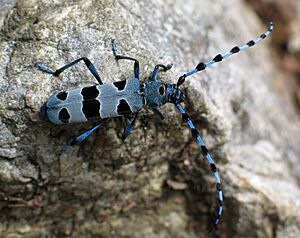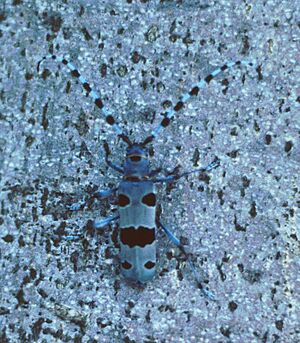Rosalia longicorn facts for kids
Quick facts for kids Rosalia longicorn |
|
|---|---|
 |
|
| Rosalia alpina | |
| Conservation status | |
| Scientific classification |
The Rosalia longicorn (Rosalia alpina), also called the Alpine longhorn beetle, is a large beetle. It belongs to a family of beetles known as longicorns or longhorn beetles (Cerambycidae). This beetle is easy to spot because of its unique markings.
Contents
What Does the Rosalia Longicorn Look Like?
The Rosalia longicorn can grow to be about 15 to 38 millimeters long. That's roughly the size of a large paperclip! Its antennae are very long. In male beetles, they can be twice as long as their body. For females, the antennae are about the same length as their body.
The beetle's wing covers, called elytra, are flat and have a blue-gray color. They have black spots that can look different on each beetle. There's usually a big black spot on its chest area (the thorax). It also has a silky spot near the front and a small one at the back. Both its antennae and legs are the same blue-gray color as its body. This special coloring helps the beetle blend in perfectly with the bark of its favorite tree, the European Beech. This is called camouflage.
Where Do Rosalia Longicorns Live?
These beetles live across a wide area. You can find them from the Cantabrian Mountains in Spain all the way east to the Caucasus region.
Sadly, the number of Rosalia longicorns in Europe has gone down a lot recently. Because of this, it is now a protected species in several countries. These include Germany, Hungary, Italy, Poland, and Slovenia. This means it is against the law to harm them or their homes in these places.
Rosalia Longicorn Life Cycle
Adult Rosalia longicorns are active during the summer months, from June to September. During the day, you might see them near flowers. They like to eat pollen from the flowers.
These beetles can make a chirping sound. They do this by rubbing their back legs against their wing covers. After mating, the female beetle lays her eggs. She carefully places them inside a small crack in the bark of beech trees.
The eggs hatch into larvae. These larvae spend about three years eating the bark of the tree. When they are old enough, they change into a pupa inside the tree. Finally, a fully grown adult beetle comes out of the pupa. Once they become adults, they live for about three to six more weeks.
Interesting Facts
The Rosalia longicorn is a very special beetle in Hungary. It is the official logo of the Danube-Ipoly National Park there.



